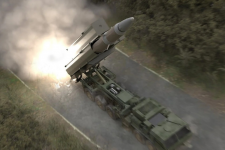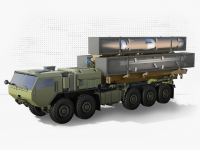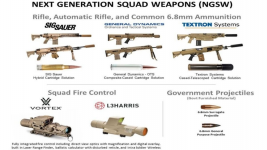US Military Updates & Discussions
- Thread starter BMD
- Start date
You are using an out of date browser. It may not display this or other websites correctly.
You should upgrade or use an alternative browser.
You should upgrade or use an alternative browser.

New Tracked Unmanned Vehicle Bristles With A Whopping 50 Switchblade Suicide Drones
General Dynamics Land Systems' TRX is a modular unmanned ground vehicle design and versions of it will be headed to an Army experiment next year.

Strykers To Get New Counter-Drone Tech With General Dynamics, Epirus Partnership - Breaking Defense
The partnership will initially integrate onto Strykers, but as has an eye on future autonomous platforms.
The US Army will test a 300 kW laser weapon system in 2022
Even if it’s only a demonstration, the system represents a significant step up from the lasers the military has had access to in the past.
What’s happening to Bradley replacement program? Are they going for Puma ? Heard that even German army is not satisfied with it and wants some upgrades in BMS.
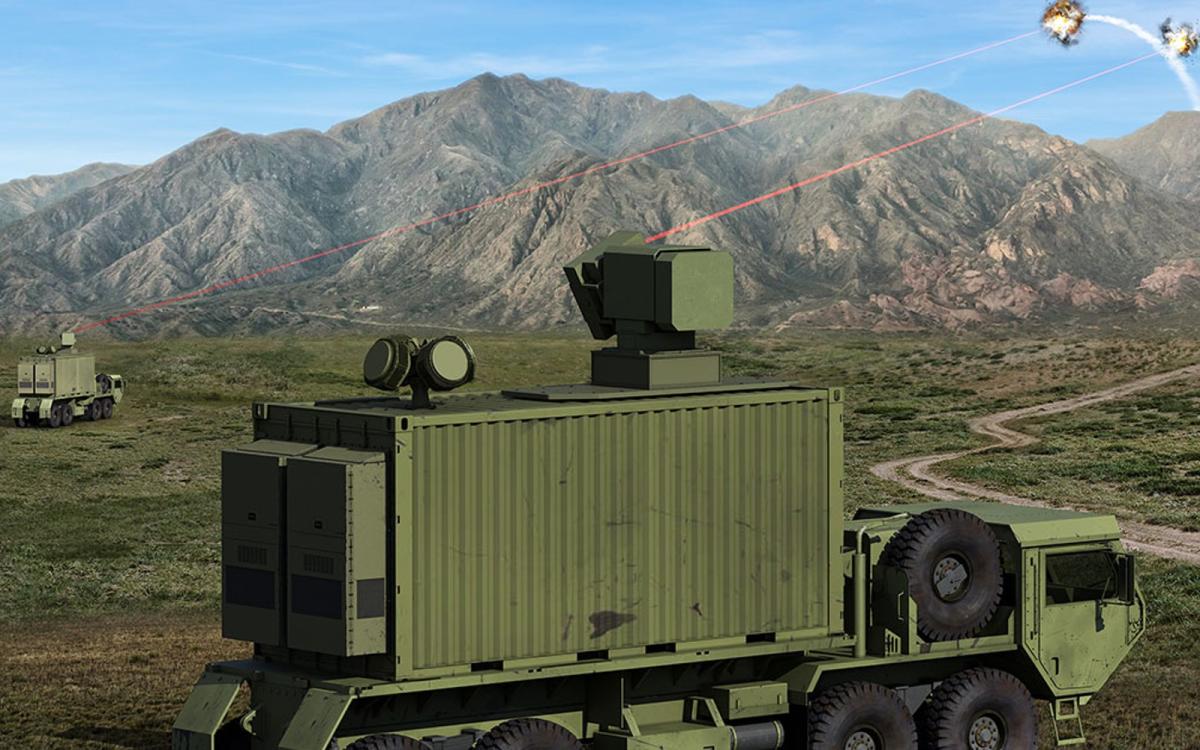
The US Army will test a 300 kW laser weapon system in 2022
Even if it’s only a demonstration, the system represents a significant step up from the lasers the military has had access to in the past.us.yahoo.com
Don't know but the Warrior replacement with CT40 autocannon is looking good should they need a fall-back plan.What’s happening to Bradley replacement program? Are they going for Puma ? Heard that even German army is not satisfied with it and wants some upgrades in BMS.

US reactivates nuclear artillery unit in Germany – why Russia should be worried
The 56th Artillery Command will be activated at Mainz-Kastel for the first time since the Cold War

Pentagon Has Tested A Suicide Drone That Gets To Its Target Area At Hypersonic Speed
The system would allow a drone to be delivered to a defended target far away in a matter of minutes, where it could then hunt down its target.
Pentagon Has Tested A Suicide Drone That Gets To Its Target Area At Hypersonic Speed
The system would allow a drone to be delivered to a defended target far away in a matter of minutes, where it could then hunt down its target.
BY JOSEPH TREVITHICK JUNE 8, 2020JOSEPH TREVITHICK View Joseph Trevithick's Articles
@FranticGoat
The Pentagon tested a loitering munition, more commonly referred to as a suicide drone, last year that will arrive over its designated target area at hypersonic speeds. It has since turned the project over to the U.S. Army for further development. Additional details about the program, dubbed Vintage Racer, have now emerged in an official picture showing Secretary of the Army Ryan McCarthy discussing it, as well as other advanced weapon systems.
Steve Trimble, Aviation Week's Defense Editor and a good friend of The War Zone, first reported on the new details about Vintage Racer after spotting the picture of McCarthy at Association of the U.S. Army's (AUSA) top annual conference and exhibition in Washington, D.C. last year. The picture was taken on Oct. 14, 2019. The program itself dates back to at least the 2017 Fiscal Year, according to Pentagon budget documents, with the Office of the Secretary of Defense receiving $2.5 million in the 2017 Fiscal Year and another $1.2 million in the 2018 Fiscal Year for the project.
THE ARMY NOW WANTS HYPERSONIC CANNONS, LOITERING MISSILES, AND A MASSIVE SUPERGUNBy Joseph TrevithickPosted in THE WAR ZONE
THE ARMY AND NAVY HAVE CONDUCTED THE FIRST JOINT TEST OF THEIR NEW HYPERSONIC WEAPONBy Joseph TrevithickPosted in THE WAR ZONE
LOCKHEED CONDUCTS FIRST TEST OF ITS NEW PRECISION STRIKE MISSILE FOR THE ARMYBy Joseph TrevithickPosted in THE WAR ZONE
F-35 CUEING ARTILLERY TO TAKE OUT AIR DEFENSE SITE DURING TEST IS A GLIMPSE OF THE FUTUREBy Joseph TrevithickPosted in THE WAR ZONE
ARMY BUYS SMALL SUICIDE DRONES TO BREAK UP HOSTILE SWARMS AND POTENTIALLY MOREBy Joseph TrevithickPosted in THE WAR ZONE
"Vintage Racer matured an advanced capability to prosecute targets of interest," a brief note about the project in the Pentagon's 2021 Budget Request says about the program. "The project successfully validated aerodynamic design with wind tunnel testing and integrated a guidance subsystem for targeted kinetic effects before culminating in a FY 2019 flight test. Documentation and prototype technologies transitioned to the U.S. Army for additional development and follow-on acquisition activities."
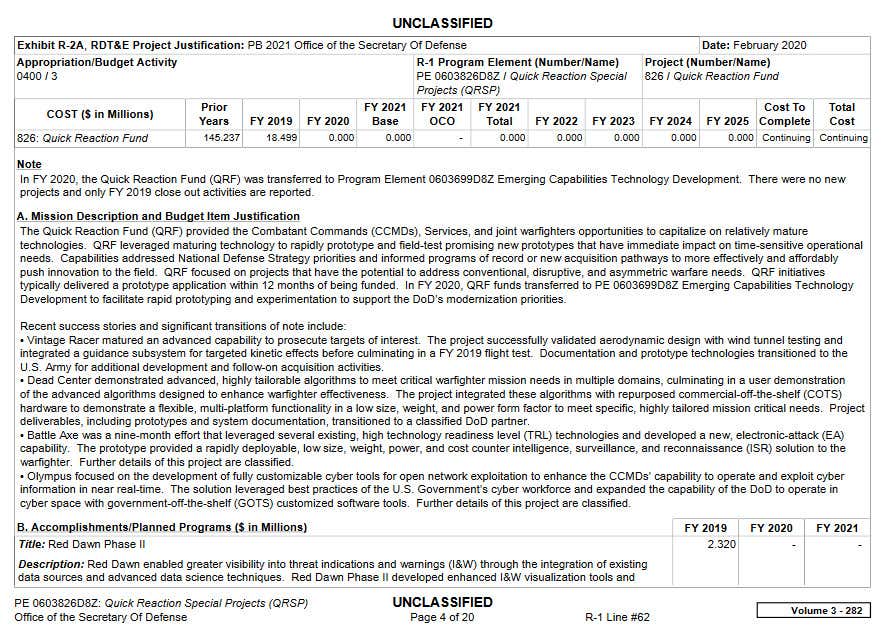
DOD
The section of the Pentagon's 2021 Fiscal Year budget request mentioning Vintage Racer.
Other budget documents say that there were originally plans for a flight demonstration in the 2018 Fiscal Year. This schedule appears to have gotten pushed back a year for unknown reasons. In addition, the 2019 Fiscal Year ended on Sept. 30, 2019, meaning that it is possible that the Army may have taken ownership of the project by the time McCarthy got the information about it at the AUSA event in Washington.

DOD
The entry on Vintage Racer from the Pentagon's 2020 budget request. Seen listed is the funding, in millions of dollars, that the program received in the 2018 Fiscal Year.

DOD
The entry on Vintage Racer from the Pentagon's 2019 budget request. Seen listed is the funding, in millions of dollars, that the program received in the 2017 Fiscal Year.
The picture of the Army Secretary at that event shows him standing in front of a small table talking with other individuals with a print out of a Vintage Racer briefing slide in front of him. A small model of the Common Hypersonic Glide Body (C-HGB) hypersonic boost-glide vehicle, which the service is developing as the warhead for its ground-launched Long Range Hypersonic Weapon (LRHW) together with the U.S. Navy, as well as a kinetic projectile similar to those fired from electromagnetic railguns, such as the one the Army has been experimenting with in recent years, are also seen. A number of metal objects with holes burned in them, including what appears to be a section of a barrel from a 155mm howitzer, possibly from a laser directed energy weapon, are also present.
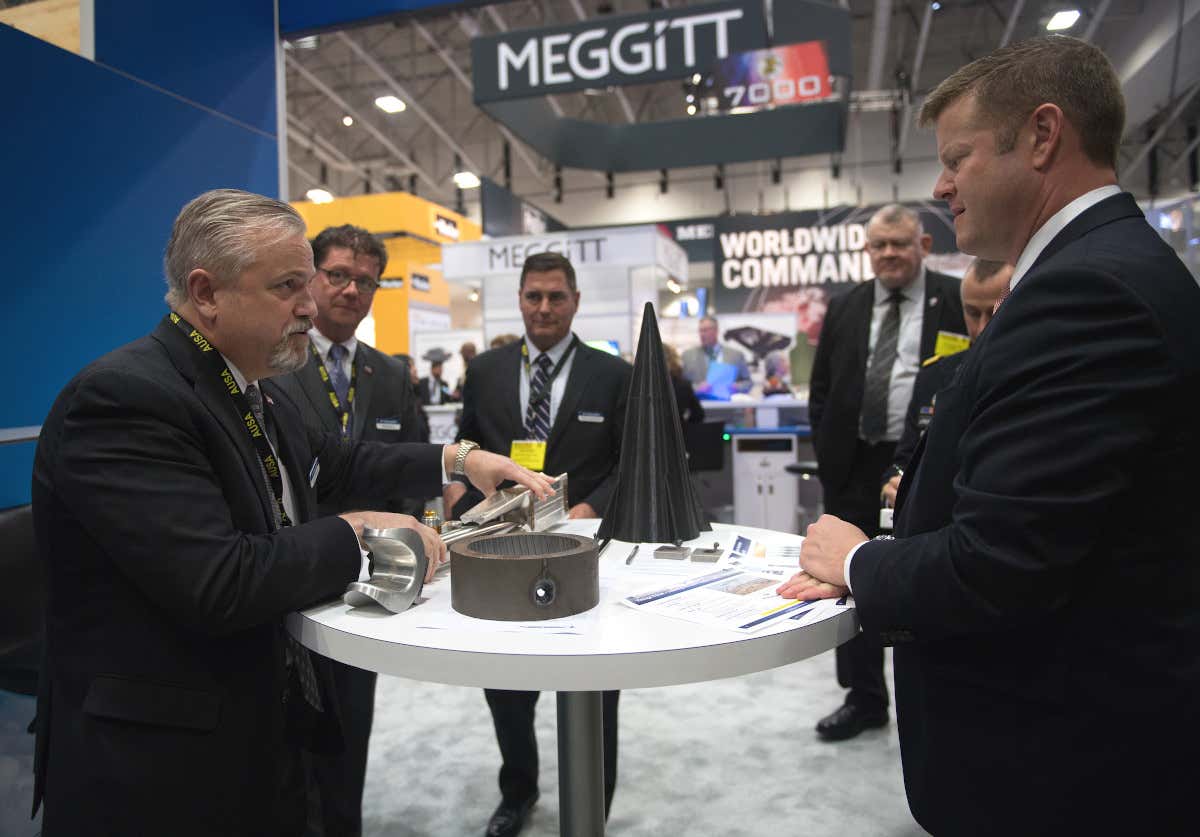
US ARMY
Secretary of the Army Ryan McCarthy at the 2019 Association of the US Army conference and exhibition on Oct. 14, 2019. His right hand is rest on a printout of a Vintage Racer briefing slide.

US ARMY
A close up of the briefing slide.
Trimble highlighted that the Vintage Racer briefing slide also has "Loitering Weapon System (LWS) Overview" in its title, as well as six large bullet points – Hypersonic Ingress, Survivable, Time Over Target, Multi-role, Modular payload, and Cost Imposition Strategy – each with a number of sub-bullet points. Aviation Week was later able to enhance the image to be able to read all of these additional highlights.
The basic idea behind Assured PNT, which you can read about more in these past War Zone pieces, is to use various means to distribute navigation system nodes across various platforms throughout the battlespace, and networking them together. The result is an ecosystem that can provide accurate and reliable position information without having to rely on GPS. Similarly, distributed communications nodes could help overcome enemy electronic warfare attacks. Beyond the Vintage Racer system's ability to provide a useful addition layer in these concepts, its rapidly deployable nature could make it an important means of filling connectivity gaps during critical operations.

BAE SYSTEMS
An infographic showing how various signal sources could provide navigation data in BAE System's Navigation via Signals of Opportunity (NAVSOP) concept, which could help provide Assured PNT.
It's worth noting that the Army actually teased the idea of using its future Precision Strike Missile (PrSM) quasi-ballistic missile as a way to deploy loitering intelligence, surveillance, and reconnaissance drones deep into enemy territory in order to provide targeting information back in 2018. Employing a mobile, ground-launched platform could further increase the system's flexibility.
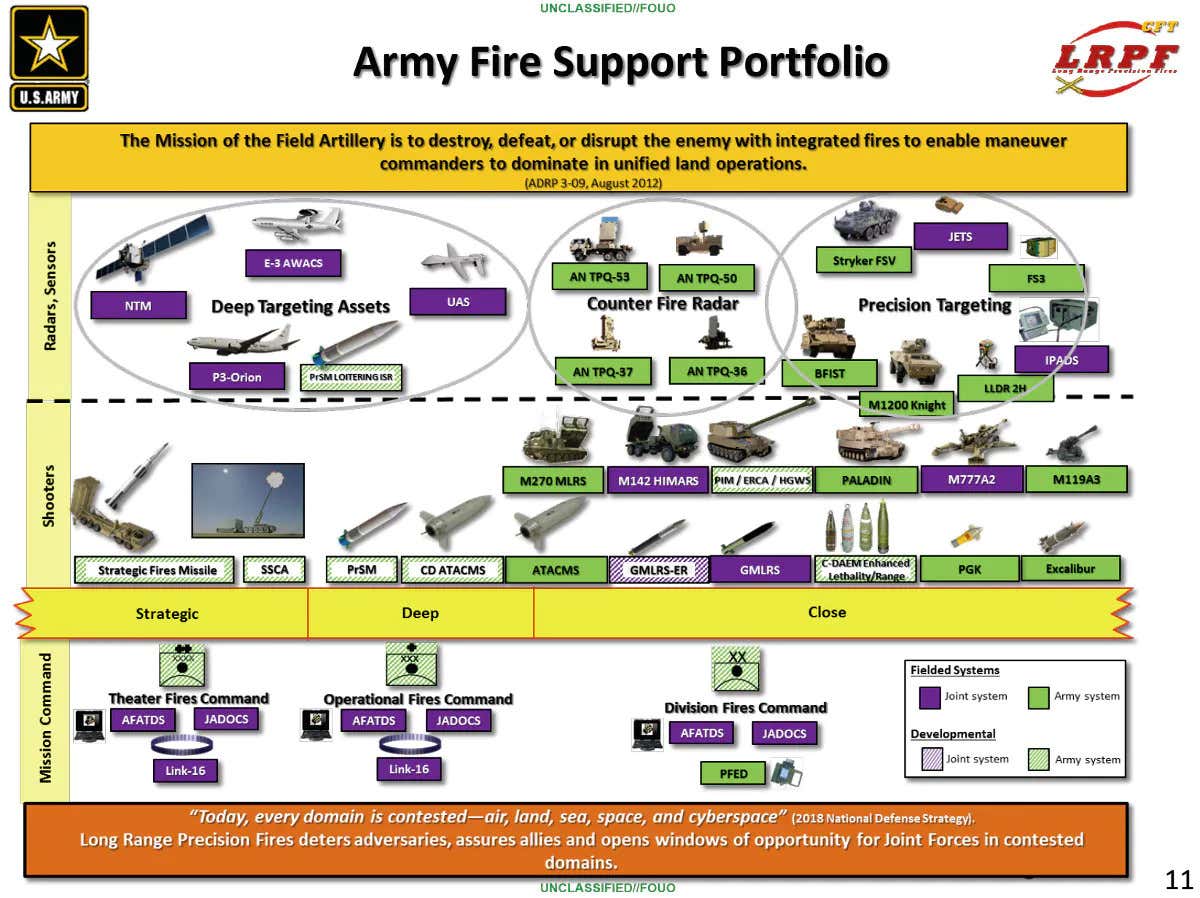
US ARMY
A 2018 Army briefing slide covering various long-range artillery and missile developments. "PrSM Loitering ISR" is mentioned in the "Deep Targeting Asset" category at the upper lefthand corner.
Lockheed Martin is developing PrSM ostensibly as a replacement for the service's existing Army Tactical Missile System (ATACMS) quasi-ballistic missiles. The Army and Lockheed Martin are also now testing a multi-mode guidance system for these missiles that could enable them to engage large moving targets, such as ships. There had previously been talk about giving ATACMS a similar moving target capability.
In the 1990s and early 2000s, the Army had worked on a version of the ATACMS that would carry a payload of 13 Brilliant Anti-Tank (BAT) submunitions, which has some broad similarities to the idea of launching drones using the PrSM, as well as the Vintage Racer concept. BAT was a small unpowered glide bomb that used acoustic sensors to find its targets and imaging infrared seeker to home in on them. The Army ultimately canceled the BAT-filled ATACMS project, though the weapons themselves evolved into the GBU-44/B Viper Strike air-launched glide bomb.
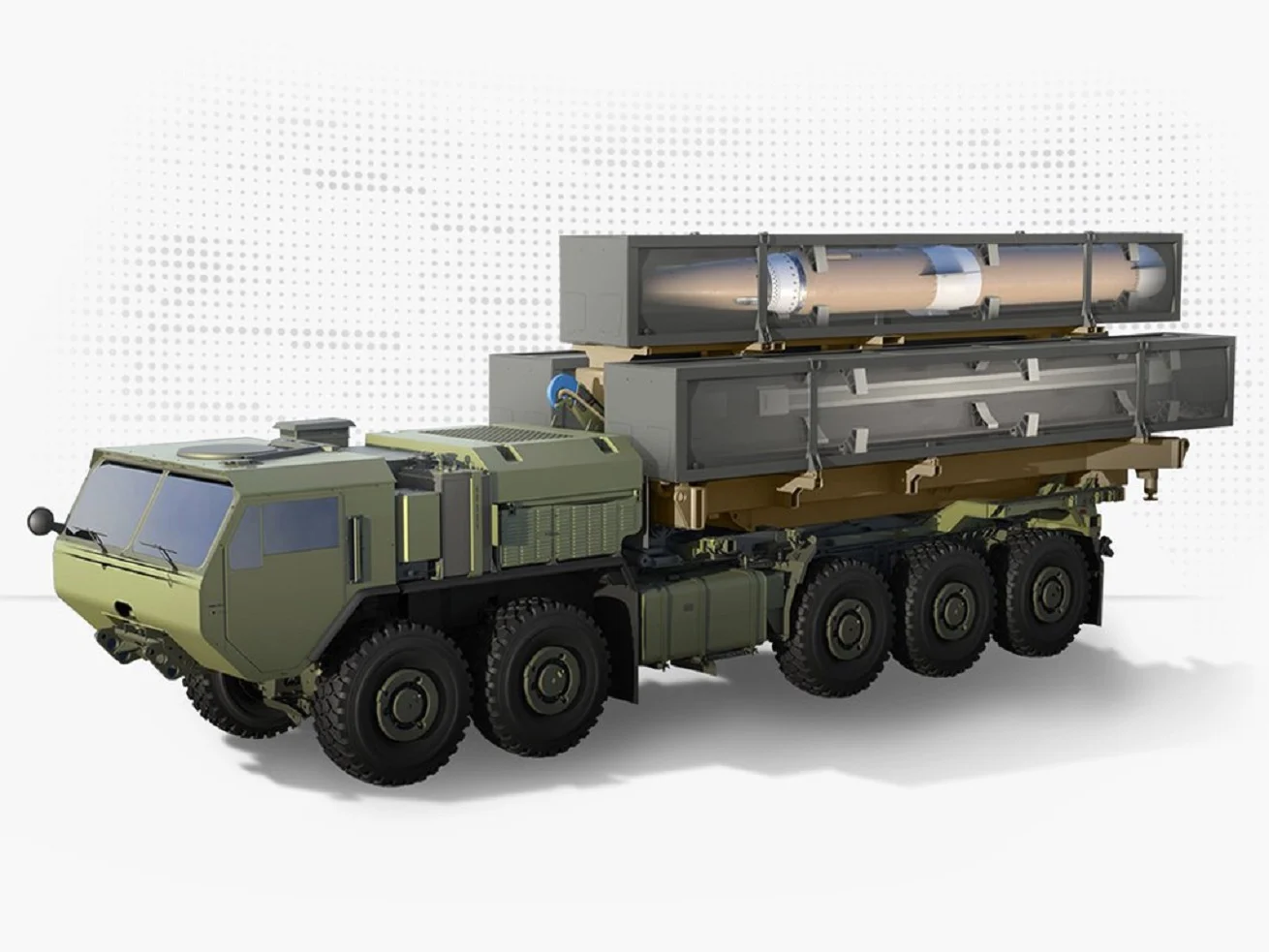
DARPA OpFires Can Provide the USMC with Mobile Hypersonic Missiles - Naval News
The Defense Advanced Research Projects Agency (DARPA) in collaboration with Lockheed Martin are developing the OpFires mobile medium-range hypersonic missile assembly to fit on the back of an U.S. Army’s Palletized Load System (PLS) 5-axle 10x10 truck. OpFires will provide the U.S. Army with a...
Home»News»DARPA OpFires Can Provide the USMC with Mobile Hypersonic Missiles

A graphic of the DARPA/Lockheed Martin OpFires medium-range hypersonic missiles on an U.S. Army Palletized Load System 10x10 truck. Lockheed Martin image.
DARPA OpFires Can Provide The USMC With Mobile Hypersonic Missiles
The Defense Advanced Research Projects Agency (DARPA) in collaboration with Lockheed Martin are developing the OpFires mobile medium-range hypersonic missile assembly to fit on the back of an U.S. Army’s Palletized Load System (PLS) 5-axle 10x10 truck. OpFires will provide the U.S. Army with a highly mobile vehicle for firing hypersonic missiles that is independent of the tractor and trailer combination for the longer-range (strategic) hypersonic missiles. The U.S. Marines may also be interested in OpFires as they use the similar Logistic Vehicle Replacement System (LVSR) 10x10 truck.
Peter Ong 23 Nov 2021The OpFires Project will use throttleable rocket motors on hypersonic missiles to achieve varying ranges in flight; therefore, OpFires can hit targets within the range envelope up to 1,000 miles (1,609 kilometers). At Mach 5+, the OpFires’ warhead can fly 1,000 miles in approximately 20 minutes.
Typically, once ignited, rocket motors burn tremendous amounts of fuel that is converted into energy to fly a certain distance at full thrust. However, to hit a target closer than the maximum range distance of the missile would require the missile to slow down or “throttle” its engine thrust to adjust for course corrections in its flight trajectory. Slowing down with unburnt fuel, equating to unexpended weight onboard, adds aerodynamic stress to the missile body casing if performed incorrectly and that might cause the missile to break apart in flight, especially at hypersonic speeds. Nonetheless, throttling the engine is necessary or else the missile might overshoot the target if the rocket motor cannot adjust its thrust levels, and that is what makes the DARPA/Lockheed Martin OpFires medium-range hypersonic missiles unique because throttling a rocket motor effectively is a difficult engineering challenge.
The U.S. Navy’s Conventional Prompt Strike (CPS) and the U.S. Army’s Long-Range hypersonic Weapon (LRHW) also use thrust-vectoring rocket motors to throttle the thrust and allow for long-range maneuvering in flight.
These hypersonic missiles fit within the U.S. Army’s Long Range Precision Fires (LRPF) strategy of differing ranges for U.S. 155mm extended-range artillery shells and for various precision missiles as outlined by Breaking Defense. The same media outlet also discusses the OpFires Project with its unique throttleable rocket motor.
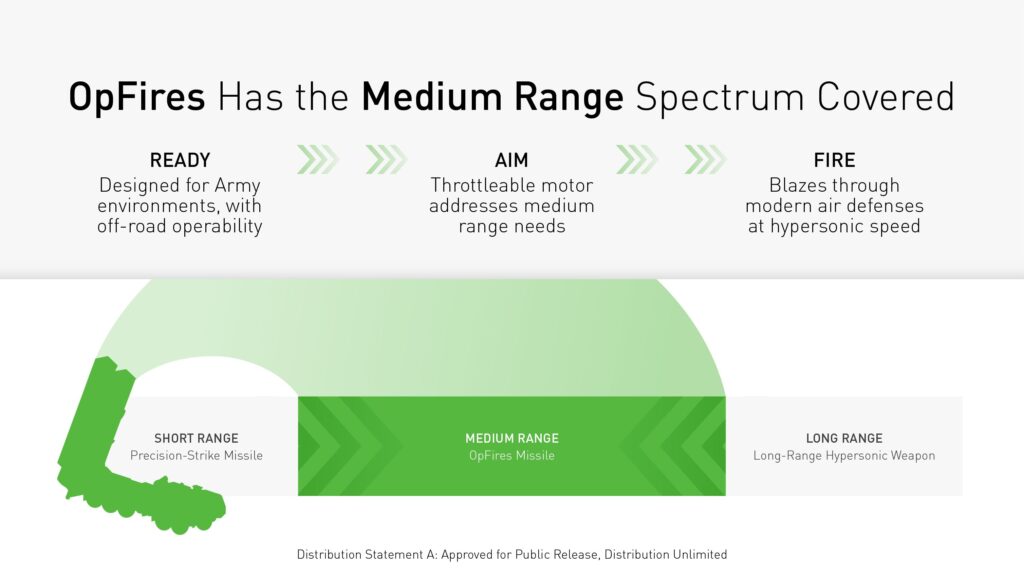
While DARPA and Lockheed Martin are developing OpFires mainly for the U.S. Army, the U.S. Marine Corps (USMC) might also take an interest because the USMC also has a 5-axle 10×10 truckthat is very similar to the cross-country U.S. Army’s Palletized Load System (PLS) tractor.

US Army and USMC interest in OpFires
Is the U.S. Army interested in OpFires that DARPA is developing? Naval News asked DARPA on if the OpFires is an official Program of Record with the U.S. Army and received a reply via email on 4 November, 2021.“We [DARPA] feel it would be inappropriate [to] speak on behalf of the [U.S.] Army with regard to their future [OpFires] plans regarding this ground-launched medium-range hypersonic weapon.
“I can note, however, just this summer we successfully completed full-scale static test firing of a second stage propulsion system that provides a solid-fuel `throttleable’ rocket motor, which can be turned off before burning through all of its fuel, allowing a missile to hit targets located anywhere within a medium-range continuum. This capability, combined with the booster’s volumetric efficiency, will help advance the development of hypersonic missiles that can literally adjust on the fly.
“Data from this and subsequent tests is being used to complete detailed design of the booster that are part of missile fabrication, assembly, and flight testing in the OpFires project’s Phase 3b, currently underway.”
Jared Adams, Chief of Communications, DARPA
Naval News also asked the U.S. Army’s Program Executive Office (PEO) for Missiles and Space for comment on OpFires. The Public Affairs PEO spokesperson forwarded the inquiry to the hypersonics Department and Naval News received no comment before publishing.
Naval News also asked the U.S. Marine Corps on if they’re interested in the DARPA OpFires program and the USMC Public Affairs spokesperson generally stated that the U.S. Marines may be interested in what the U.S. Army does with the DARPA OpFires program. Naval News interprets the Marines’ comment similar to DARPA’s comment in that the U.S. Army and U.S. Marines do not want to prematurely commit to OpFires just yet, pending on testing and development progress with DARPA.
The graphics of the OpFires PLS and LVSR do not appear to show the OpFires launcher assembly being able to rotate, but with a throttleable rocket motor, the hypersonic missile should in theory, be able to course-correct, maneuver and steer in any direction to fly to targets to the side or behind the OpFires launcher. Does the PLS and LVSR have to steer towards the direction of the threat, meaning that the hypersonic missiles can only fire and fly forward?
Without confirming on if the OpFires missile can veer to the sides or make a U-turn mid-course to fly behind the elevated launcher, DARPA simply stated that, “OpFires is maneuverable, and the extinguishable propellant technology allows the operational system to hold a broad kinematic footprint of targets at risk.”
Naval News comments
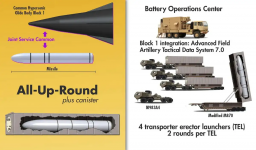 The U.S. Navy’s (and possibly Marines’) Conventional Prompt Strike and the U.S. Army’s Long-Range Hypersonic Weapon require a tractor-trailer combination to drive into position and fire. OpFires negates this method by using an off-road capable 10×10 truck as the launching platform. Source: U.S. Army
The U.S. Navy’s (and possibly Marines’) Conventional Prompt Strike and the U.S. Army’s Long-Range Hypersonic Weapon require a tractor-trailer combination to drive into position and fire. OpFires negates this method by using an off-road capable 10×10 truck as the launching platform. Source: U.S. ArmyNaval News will speculatively for discussion purposes analyze the DARPA OpFires benefits to the U.S. Army and to the U.S. Marines if they do decide to adopt OpFires as an official Program of Record as depicted on the 5-axle 10×10 wheeled PLS and LVSR truck graphics.
OpFires Increases Tactical Hypersonic Missile Capability
Three main issues affect the current longer-range U.S. Navy’s Conventional Prompt Strike (CPS) and the U.S. Army’s Long-Range Hypersonic Weapon (LRHW) missiles.One is “tactical mobility.” CPS and LRHW both require one 45.5-feet long M870A3 trailer and a 34 feet (10.4 meter) M983A4 tractor to tow two CPS or LRHW hypersonic missiles per trailer. This tractor-trailer combination can be bulky, unwieldly, and not as mobile and deployable as an independent self-contained all-wheel drive cross-country truck with hypersonic missiles on its back and no trailer to tow because free-wheeling trailers can get stuck in terrain or jackknife. Thus, long trailers are often limited to even terrain and roads and require large ground clearings to fire their missiles. Furthermore, seen as a “Strategic asset,” CPS and LRHW might be deployed in major conflicts, not regional crisis or everyday patrols and deterrent missions.
Second is “logistics spacing.” The CPS and LRHW tractor-semi trailer Transporter Erector Launcher (TEL) combination is roughly 80 feet long, or too long to fit aboard a U.S. Navy’s Landing Craft Air Cushion (LCAC) or Surface to Shore Connector (SSC) hovercraft for transport to the beach. The CPS and LRHW can fit inside and/or on the Navy’s Light Amphibious Warship (LAW) and Landing Craft Utility (LCU), slow and smaller transport crafts with speeds of around 11-14 knots compared to the LCAC and SSC hovercrafts with speeds of 40+ knots. The ability to deploy CPS and LRHW requires larger cargo aircraft and vessels than one 10×10 wheeled truck. Being mounted on trailers, they often assume parked firing positions, having to find a space large enough to accommodate the 80-foot-long system to fire two 34.5” (2.87 feet or 0.87 meters) diameter hypersonic missiles. Reload times aren’t short and easy as the entire missile canister needs to be replaced on the trailer with a large crane.
 September 15, 2021. The delivery of the first prototype hypersonic hardware to soldiers of the 5th Battalion, 3rd Field Artillery Regiment, 17th Field Artillery Brigade is completed on Oct. 7, 2021, with a ceremony at Joint Base Lewis-McChord, Washington. [Author’s Note: Notice the size of the wheeled crane required to lift an inert LRHW canister onto a M870A3 trailer. In a combat environment, this crane needs to come along to reload LRHW and CPS hypersonic missiles]. (U.S. Army photo by Spc. Karleshia Gater)
September 15, 2021. The delivery of the first prototype hypersonic hardware to soldiers of the 5th Battalion, 3rd Field Artillery Regiment, 17th Field Artillery Brigade is completed on Oct. 7, 2021, with a ceremony at Joint Base Lewis-McChord, Washington. [Author’s Note: Notice the size of the wheeled crane required to lift an inert LRHW canister onto a M870A3 trailer. In a combat environment, this crane needs to come along to reload LRHW and CPS hypersonic missiles]. (U.S. Army photo by Spc. Karleshia Gater)Third is cost. The CPS and LRHW fly at ranges of over 1,725 miles (2,776 kilometers) and are larger, expensive, rare, and often used against the most important strategic targets. Both missiles use a Common Hypersonic Glide Body (CHGB) warhead that separates from the missile body and flies down on the target at speeds in excess of Mach 5, destroying the target with kinetic force alone.
OpFires remedies the first issue of tactical mobility with the Army PLS or USMC LVSR 5-axle 10×10 wheeled truck that excels in cross-country mobility and has a better turning radius than a trailer. OpFires is self-contained, and as the top graphic shows, the three missiles fit on a rail assembly system that can be loaded onto the back of a 5-axle truck. The entire missile assembly system can be removed for reloading or for converting the PLS and LVSR back into a logistics vehicle. The PLS and LVSR often have an armored cab and could also have rooftop weapons for self-defense.
This outdated graphic below shows seven LVSRs in a U.S. Marine Expeditionary Unit (MEU). The AAVs are being replaced by Amphibious Combat Vehicles (ACV), the AV-8Bs by F-35Bs, and all four M1A1 Abrams tanks have since been divested in a MEU. Theoretically, if four more LVSRs were added to replace the four divested M1A1 tanks in the MEU, the USMC can hypothetically have 11 LVSRs with three hypersonic missiles each, equating to 33 medium-range ready-to-fire hypersonic missiles in a single standard deployment MEU. Since OpFires is a detachable rail rack off the back of the LVSRs, more than 11 OpFires medium-range hypersonic missile system assemblies can be aboard a MEU.
 A U.S Marine Expeditionary Unit might have four more LVSRs to replace the four divested M1A1 Abrams tanks for 11 LVSRs, carrying 33 medium-range ready-to-fire hypersonic missiles, each missile with a 1,000-mile range and reloaded by the two engineer cranes. Source: USMC.
A U.S Marine Expeditionary Unit might have four more LVSRs to replace the four divested M1A1 Abrams tanks for 11 LVSRs, carrying 33 medium-range ready-to-fire hypersonic missiles, each missile with a 1,000-mile range and reloaded by the two engineer cranes. Source: USMC.According to the MAGTF graphic, 30 MTVRs are carried aboard a MEU, and while the MTVRs come in many variants, one can assume that some of them are the MTVR Mark 27 and Mark 28 Extended Cargo Trucks (20-foot body) or the Mark 37 HIMARS Resupply Vehicle, meaning that these MTVRs can in theory carry more OpFires missile containers or the entire three-missile erector launch assembly for the LVSR and reload them in the field, theoretically meaning more than 33 missiles on 11 LVSRs. Such a MTVR logistics capability would be advantageous for the Marine Corps as the LVSR Transporter Erector Launchers (TELs) would not have to return to a forward staging base (FSB) or the amphibious ship to resupply with OpFires medium-range hypersonic missiles, but instead have the MTVRs drive to their locations to resupply and rearm for true “Shoot and Scoot” Long-Range Precision Fires (LRPF) capabilities. The MEU’s LCACs, LCUs, and KC-130J cargo aircraft also provide logistics support to OpFires and the Marines’ LRPF tactical mobility capabilities that may also include CPS trailers and NMESIS Naval Strike Missiles depending on the situation.
The MEU graphic also appears to show two wheeled cranes (Engineers) that can unload and replace the entire OpFires assembly or replace individual fired hypersonic missile containers on the LVSRs.
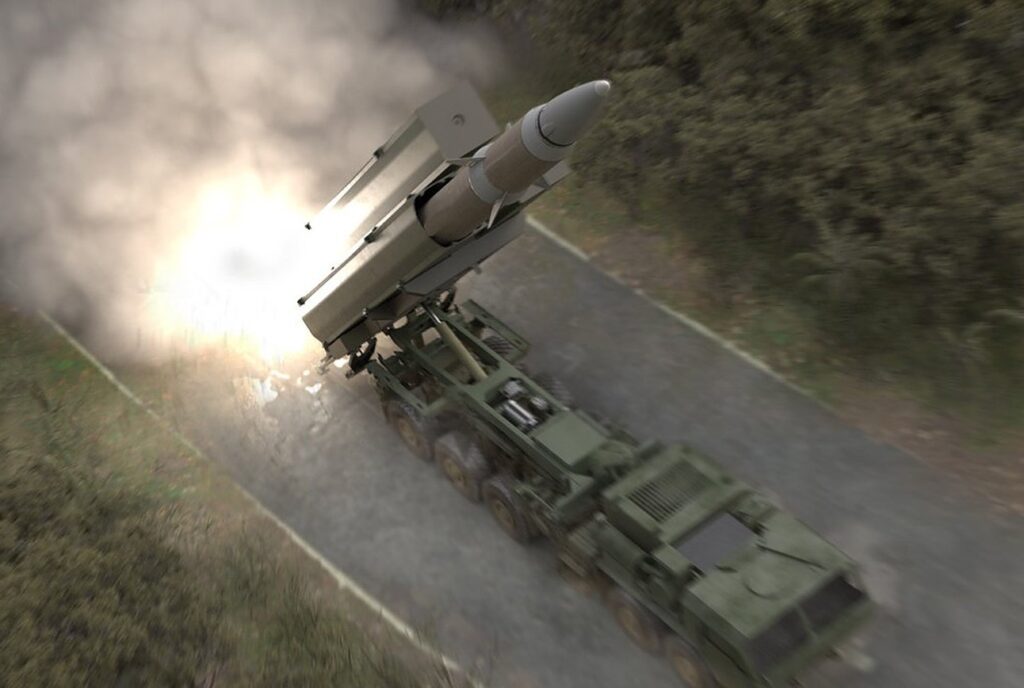
To address the second issue of “logistics spacing,” at 36.02 feet (10.98 meters) long and 8.16 feet (2.49 meters) wide, the USMC’s LVSR will fit aboard the 67-foot cargo area deck of the LCAC and SSC hovercrafts. The U.S. Army’s PLS shares about the same dimensions, give or take a foot and a few inches, compared to the Marines’ LVSR.
Finally, OpFires addresses cost as the entire unit is self-contained and removable and being smaller, should cost less than the strategic Marines’ CPS and the Army’s LRHW missiles.
OpFires Usage and Benefits to the U.S. Marine Corps and to the U.S. Navy
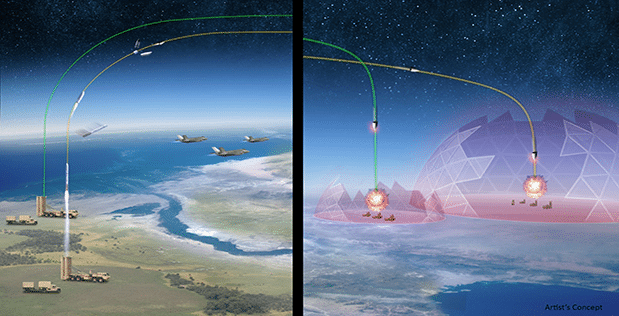
OpFires hypersonic missile is launched from a mobile Transporter Erector Launcher (TEL) and flies at a high ballistic arc to release a warhead that dives down on tactical targets such as enemy armor, vehicles, structures, and underground bunkers. The graphic shows launched OpFires missiles eliminating mobile radar and SAM vehicles before F-35s enter the combat zone. DARPA image.
With over a 1,000-mile range, OpFires’ medium-range hypersonic missiles are intended to penetrate Anti-Access/Area Denial (A2AD) situations with warheads that dive down on targets such as Surface to Air Missile (SAM) vehicles and sites, Anti-Ship missile vehicles and sites, mobile missile launchers, shore-based communications and sensors, radar sites, artillery sites, and fixed structures that threaten a naval strike and amphibious force. OpFires would offer a huge tactical mobility capability and benefit for the USMC and the U.S. Navy if OpFires can be launched from ships at sea such as from the open-deck LUSV. Thus, outside or near the edge of the adversary’s Weapons Engagement Zone, the U.S. Navy and the USMC can attack land and shore-based targets from a standoff distance before the shorter-ranged fighter/bombers flying off of aircraft carriers enter the scene. OpFires will increase the LRPF distance of the naval force for the Combat Commander, providing a game changing force multiplier instead of waiting for the toted U.S. Army’s 1,000-mile cannon with extended-range GPS shells that may or may not come into fruition.
Attachments
Armor crews fire new barricade-busting tank round
The 120mm XM1147 AMP will replace four legacy tank rounds.

The Linchpin For Army Evolution To Multi-Domain Operations Is Already Here: Gray Eagle - Breaking Defense
What Army leaders want out of future battlefield systems is a stable hardware enabled by powerful software that makes it easy to upgrade, integrate accessories and accomplish their tasks.
I suppose both the F-35 & F-22 are the crowning glory of such advanced thoughts , isn't it Paddy or is this philosophy the benefit of hindsight due to the trials & tribulations in developing & maintaining the aforementioned systems ?
The Linchpin For Army Evolution To Multi-Domain Operations Is Already Here: Gray Eagle - Breaking Defense
What Army leaders want out of future battlefield systems is a stable hardware enabled by powerful software that makes it easy to upgrade, integrate accessories and accomplish their tasks.breakingdefense.com

Soldier touchpoints guide successful autonomous launcher demo
DEVCOM AvMC successfully demonstrated proof of concept for an Autonomous Multi-Domain Launcher, culminating with a multi-round live fire demonstration.
Looks like this is part of a larger trend. Multiple handles on Twitter are reporting this.
My own personal experience with batch mates, ex colleagues,relatives, friends etc confirms it.
Looks like most white collar workers have had a bit of an epiphany during the pandemic & quit their jobs with no plans in the immediate future of seeking employment instead trying to see the grand purpose behind the lives they've lead & wish to lead .
Ofc this is a privileged group we're talking about who're asset heavy, mortgage lite with a decent investment cum saving portfolio.
But the sheer numbers are mind boggling.

